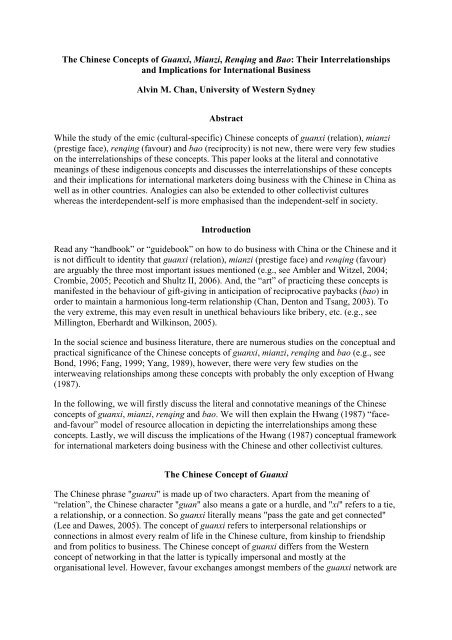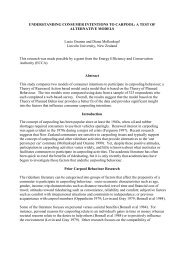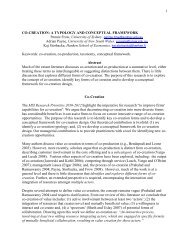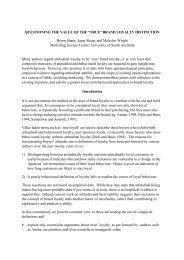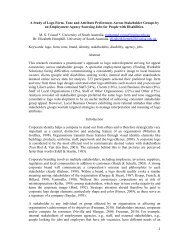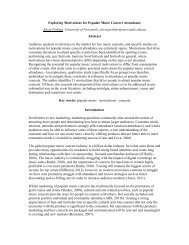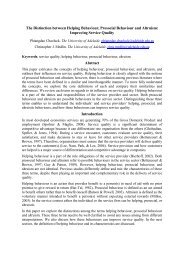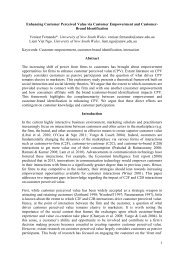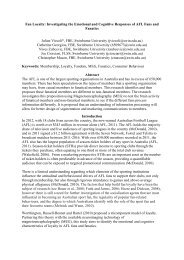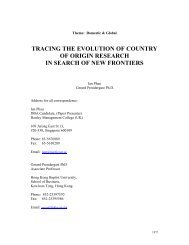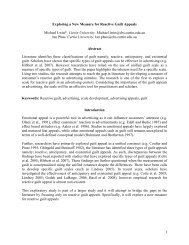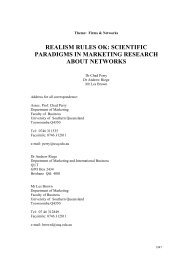The Chinese Concepts of Guanxi, Mianzi, Renqing and ... - ANZMAC
The Chinese Concepts of Guanxi, Mianzi, Renqing and ... - ANZMAC
The Chinese Concepts of Guanxi, Mianzi, Renqing and ... - ANZMAC
Create successful ePaper yourself
Turn your PDF publications into a flip-book with our unique Google optimized e-Paper software.
<strong>The</strong> <strong>Chinese</strong> <strong>Concepts</strong> <strong>of</strong> <strong>Guanxi</strong>, <strong>Mianzi</strong>, <strong>Renqing</strong> <strong>and</strong> Bao: <strong>The</strong>ir Interrelationships<br />
<strong>and</strong> Implications for International Business<br />
Alvin M. Chan, University <strong>of</strong> Western Sydney<br />
Abstract<br />
While the study <strong>of</strong> the emic (cultural-specific) <strong>Chinese</strong> concepts <strong>of</strong> guanxi (relation), mianzi<br />
(prestige face), renqing (favour) <strong>and</strong> bao (reciprocity) is not new, there were very few studies<br />
on the interrelationships <strong>of</strong> these concepts. This paper looks at the literal <strong>and</strong> connotative<br />
meanings <strong>of</strong> these indigenous concepts <strong>and</strong> discusses the interrelationships <strong>of</strong> these concepts<br />
<strong>and</strong> their implications for international marketers doing business with the <strong>Chinese</strong> in China as<br />
well as in other countries. Analogies can also be extended to other collectivist cultures<br />
whereas the interdependent-self is more emphasised than the independent-self in society.<br />
Introduction<br />
Read any “h<strong>and</strong>book” or “guidebook” on how to do business with China or the <strong>Chinese</strong> <strong>and</strong> it<br />
is not difficult to identity that guanxi (relation), mianzi (prestige face) <strong>and</strong> renqing (favour)<br />
are arguably the three most important issues mentioned (e.g., see Ambler <strong>and</strong> Witzel, 2004;<br />
Crombie, 2005; Pecotich <strong>and</strong> Shultz II, 2006). And, the “art” <strong>of</strong> practicing these concepts is<br />
manifested in the behaviour <strong>of</strong> gift-giving in anticipation <strong>of</strong> reciprocative paybacks (bao) in<br />
order to maintain a harmonious long-term relationship (Chan, Denton <strong>and</strong> Tsang, 2003). To<br />
the very extreme, this may even result in unethical behaviours like bribery, etc. (e.g., see<br />
Millington, Eberhardt <strong>and</strong> Wilkinson, 2005).<br />
In the social science <strong>and</strong> business literature, there are numerous studies on the conceptual <strong>and</strong><br />
practical significance <strong>of</strong> the <strong>Chinese</strong> concepts <strong>of</strong> guanxi, mianzi, renqing <strong>and</strong> bao (e.g., see<br />
Bond, 1996; Fang, 1999; Yang, 1989), however, there were very few studies on the<br />
interweaving relationships among these concepts with probably the only exception <strong>of</strong> Hwang<br />
(1987).<br />
In the following, we will firstly discuss the literal <strong>and</strong> connotative meanings <strong>of</strong> the <strong>Chinese</strong><br />
concepts <strong>of</strong> guanxi, mianzi, renqing <strong>and</strong> bao. We will then explain the Hwang (1987) “face<strong>and</strong>-favour”<br />
model <strong>of</strong> resource allocation in depicting the interrelationships among these<br />
concepts. Lastly, we will discuss the implications <strong>of</strong> the Hwang (1987) conceptual framework<br />
for international marketers doing business with the <strong>Chinese</strong> <strong>and</strong> other collectivist cultures.<br />
<strong>The</strong> <strong>Chinese</strong> Concept <strong>of</strong> <strong>Guanxi</strong><br />
<strong>The</strong> <strong>Chinese</strong> phrase "guanxi" is made up <strong>of</strong> two characters. Apart from the meaning <strong>of</strong><br />
“relation”, the <strong>Chinese</strong> character "guan" also means a gate or a hurdle, <strong>and</strong> "xi" refers to a tie,<br />
a relationship, or a connection. So guanxi literally means "pass the gate <strong>and</strong> get connected"<br />
(Lee <strong>and</strong> Dawes, 2005). <strong>The</strong> concept <strong>of</strong> guanxi refers to interpersonal relationships or<br />
connections in almost every realm <strong>of</strong> life in the <strong>Chinese</strong> culture, from kinship to friendship<br />
<strong>and</strong> from politics to business. <strong>The</strong> <strong>Chinese</strong> concept <strong>of</strong> guanxi differs from the Western<br />
concept <strong>of</strong> networking in that the latter is typically impersonal <strong>and</strong> mostly at the<br />
organisational level. However, favour exchanges amongst members <strong>of</strong> the guanxi network are
not solely commercial, but also social, involving the exchange <strong>of</strong> renqing <strong>and</strong> the giving <strong>of</strong><br />
mianzi (Luo, 1997b).<br />
Yang (1992) distinguished three groups <strong>of</strong> <strong>Chinese</strong> relationships: (1) jiajen (family members),<br />
shoujen (relatives outside the family, friends, neighbours, classmates, <strong>and</strong> colleagues), <strong>and</strong><br />
shengjen (strangers). <strong>The</strong>se distinctions are consistent with Hwang’s (1987) conception <strong>of</strong> the<br />
three major guanxi categories in <strong>Chinese</strong> societies.<br />
Chang <strong>and</strong> Holt (1991) identified four common methods that one might establish guanxi with<br />
another: (1) appealing to kin relations; (2) pointing to a previous association; (3) using ingroup<br />
connections or mediators; or (4) social interaction requiring social skills such as the<br />
ability to play the “renqing (favour) game”.<br />
Empirical evidence suggested that guanxi-based business variables have pr<strong>of</strong>ound <strong>and</strong><br />
positive impacts on the efficiency <strong>and</strong> growth <strong>of</strong> companies doing business in China (e.g., see<br />
Luo, 1997a; Luo <strong>and</strong> Chen, 1997; So <strong>and</strong> Speece, 2000).<br />
<strong>The</strong> <strong>Chinese</strong> Concept <strong>of</strong> <strong>Mianzi</strong><br />
While it is argued that face behaviour is universal, the concept <strong>of</strong> face is <strong>Chinese</strong> in origin <strong>and</strong><br />
is a literal translation <strong>of</strong> the Chinse terms <strong>of</strong> mianzi <strong>and</strong> lian (G<strong>of</strong>fman, 1955; Ho, 1976). Hu<br />
(1944, p. 45-46) made very clear distinctions between the two <strong>Chinese</strong> words for “face”: lien<br />
(or lian) <strong>and</strong> mien (or mian):<br />
“Of the two words for ‘face’: lien <strong>and</strong> mien, the latter is by far the older, being found<br />
in ancient literature. Mien has acquired a figurative meaning referring to the relation<br />
between ego <strong>and</strong> society as early as the fourth century B.C. Lien is a more modern<br />
term, the earliest reference cited in the K’ang-hsi Dictionary dating from the Yuan<br />
Dynasty (1277-1367). This word seems to have originated somewhere in North China<br />
<strong>and</strong> gradually to have supplanted mien in the physical sense, <strong>and</strong> also to have acquired<br />
some <strong>of</strong> its figurative meaning. Meanwhile, mien, with the meaningless syllable –tzu<br />
(zi) attached, had developed different connotations”.<br />
On the physical level, both lian <strong>and</strong> mian(zi) mean the physical “face”. On the connotative<br />
level, mianzi st<strong>and</strong>s for the kind <strong>of</strong> prestige or reputation achieved through getting on in life,<br />
through success <strong>and</strong> ostentation; mianzi is accumulated by means <strong>of</strong> personal effort or clever<br />
maneuvering. <strong>Mianzi</strong> is therefore a kind <strong>of</strong> recognition ego dependent on the external<br />
environment. Lian is the respect <strong>of</strong> the group for a man with a good moral reputation; it<br />
represents the confidence <strong>of</strong> society in the integrity <strong>of</strong> ego’s moral character, the loss <strong>of</strong> which<br />
makes it impossible for a person to function properly within the community. Lian is therefore<br />
both a social sanction for enforcing moral st<strong>and</strong>ards <strong>and</strong> an internalised sanction (Hu, 1944).<br />
Hu (1944) indicated that the Western concept <strong>of</strong> “face” corresponds to the <strong>Chinese</strong> mianzi but<br />
is lacking in the connotation <strong>of</strong> lian.<br />
<strong>The</strong> loss <strong>of</strong> mianzi simply means that a person does not deserve the honour or glory.<br />
However, a sense <strong>of</strong> self-blame or shame is association with the loss <strong>of</strong> lian as a result <strong>of</strong><br />
wrong-doing regardless <strong>of</strong> the presence <strong>of</strong> an audience (Bond <strong>and</strong> Hwang, 1986). <strong>The</strong><br />
importance <strong>of</strong> lian in day to day life <strong>of</strong> the <strong>Chinese</strong> is reflected in the old saying: “Every<br />
person needs lian; every tree needs bark.” As Hu (1994, p. 63) put it, “A person with a feeling<br />
for lien can be trusted implicitly, for lien is worth more than a fortune to those who value it.”
Redding <strong>and</strong> Ng (1982) also found that the fear <strong>of</strong> losing lian formed the basis for the<br />
informal system <strong>of</strong> contracts <strong>and</strong> agreements that is common in <strong>Chinese</strong> businesses, but<br />
mianzi entered much more into everyday transactions as a form <strong>of</strong> social currency.<br />
Results <strong>of</strong> an online survey conducted by the Sina Corporation (1998), one <strong>of</strong> China’s largest<br />
Internet Service Provides, on <strong>Chinese</strong> respondents’ attitudes towards mianzi indicated that <strong>of</strong><br />
the 1235 responses, 83.2 % thought that in <strong>Chinese</strong> social interactions, mianzi is “very<br />
important” <strong>and</strong> 12.1% thought that it is “somewhat important” (2.7% “not important” <strong>and</strong><br />
1.9% “no opinion”). When asked their opinions towards mianzi as a cultural phenomenon,<br />
although 27.8% agreed that “it is a cultural rubbish <strong>and</strong> should be thrown away”, more that<br />
half <strong>of</strong> the respondents (52.0%) suggested that “it is neither good nor bad; it is useful anyway”<br />
<strong>and</strong> some 15.7% <strong>of</strong> the respondents actually thought that “it is very good; good for<br />
communication with others”; a small percentage (4.8%) <strong>of</strong> the respondents thought that “have<br />
or do not have mianzi does not matter”.<br />
<strong>The</strong> above survey results do not just indicate the importance <strong>of</strong> mianzi in the <strong>Chinese</strong> culture;<br />
they also reflect the interdependence <strong>of</strong> the concepts <strong>of</strong> mianzi <strong>and</strong> guanxi in social <strong>and</strong><br />
business interactions in <strong>Chinese</strong> societies. However, it must be pointed out that mianzi is a<br />
necessary, but insufficient, condition to build guanxi in China.<br />
<strong>The</strong> <strong>Chinese</strong> <strong>Concepts</strong> <strong>of</strong> <strong>Renqing</strong> <strong>and</strong> Bao<br />
<strong>The</strong> <strong>Chinese</strong> character “ren” literally means “a person or a human being” <strong>and</strong> “qing” literally<br />
means “emotion or feeling”. <strong>The</strong> concept <strong>of</strong> renqing has three implications in the <strong>Chinese</strong><br />
culture: (1) renqing indicates the affective responses <strong>of</strong> an individual confronting different<br />
situations; (2) renqing means a resource that an individual can present to another as a gift in<br />
the course <strong>of</strong> social interaction; <strong>and</strong> (3) renqing connotes the social norms by which one has<br />
to abide in order to get along well with other people (Gabrenya, Jr. <strong>and</strong> Hwang, 1996).<br />
<strong>The</strong> <strong>Chinese</strong> concept <strong>of</strong> “bao” is inseparable from the concept <strong>of</strong> “renqing” as reflected in the<br />
old <strong>Chinese</strong> saying that “(repaying) renqing is more pressing than that <strong>of</strong> (repaying) debt”.<br />
Yang (1957) elaborated extensively on how the concept <strong>of</strong> bao works in the <strong>Chinese</strong> culture:<br />
“<strong>The</strong> <strong>Chinese</strong> believe that reciprocity <strong>of</strong> action (favor <strong>and</strong> hatred, reward <strong>and</strong><br />
punishment) between man <strong>and</strong> man, <strong>and</strong> indeed between men <strong>and</strong> supernatural beings,<br />
should be as certain as a cause <strong>and</strong> effect relationship, <strong>and</strong>, therefore, when a <strong>Chinese</strong><br />
acts, he normally anticipates a response on return.” (Yang, 1957, p. 291)<br />
<strong>The</strong> <strong>Chinese</strong> concept <strong>of</strong> bao differs from the Western concept <strong>of</strong> reciprocity in that the units<br />
involved in the <strong>Chinese</strong> concept <strong>of</strong> bao are mostly families, not individuals. I.e., the return <strong>of</strong><br />
renqing does not have to be directed towards the original giver; it can be directed towards<br />
other family members or even close acquaintances (Yang, 1989).<br />
<strong>The</strong> Interrelationships among <strong>Guanxi</strong>, <strong>Mianzi</strong>, <strong>Renqing</strong> <strong>and</strong> Bao<br />
Based on social exchange theory, Hwang (1987) developed a conceptual “face-<strong>and</strong>-favour”<br />
model <strong>of</strong> resource allocation for fathoming the dynamic relationships among the <strong>Chinese</strong><br />
concepts <strong>of</strong> guanxi, mianzi, renqing <strong>and</strong> bao (see Figure 1).
This simplified dyadic interaction between the “petitioner” <strong>and</strong> the resources “allocator”<br />
depicted in Figure 1 can be extended to interpret the interactions among more people. In the<br />
interaction process, the two parties may interchangeably play the role <strong>of</strong> petitioner <strong>and</strong><br />
allocator at different times.<br />
Figure 1: A <strong>The</strong>oretical Model <strong>of</strong> Face <strong>and</strong> Favour in <strong>Chinese</strong> Society<br />
Source: Hwang (1987, p. 948)<br />
Justice theories suggested that there are three justice norms that are used for social exchange<br />
for distributing resources within groups: (1) the equity rule which dictates that resources be<br />
distributed in proportion to individuals’ contributions; (2) the equality rule which dictates that<br />
resources be distributed equally among members regardless <strong>of</strong> their objective contributions;<br />
<strong>and</strong> (3) the need rule which dictates that resources be distributed to satisfy individuals’<br />
legitimate needs regardless <strong>of</strong> their relative contributions (Hwang, 1987).<br />
When the resource allocator is asked to mete out a social resource to benefit the petitioner, he<br />
or she will first consider: “What is the guanxi between us? How strong is our guanxi?”<br />
Hwang (1987) divided relationships into three categories which correspond with the three<br />
types <strong>of</strong> <strong>Chinese</strong> relationships identified by Yang (1992): Expressive ties are common within<br />
the jiajen relation (family members) <strong>and</strong> involves exchanges based primarily on need. <strong>The</strong><br />
instrumental ties are based largely on equity principles <strong>and</strong> are most common within the<br />
shengjen relations (strangers). <strong>The</strong> mixed ties are based on influence <strong>and</strong> are common within<br />
the shoujen relationship (relatives outside the family, friends, neighbours, classmates, <strong>and</strong><br />
colleagues) (Kwang, 1987; Yang, 1992).<br />
Hwang (1987) argued that renqing is a variant <strong>of</strong> the universal equality rule <strong>and</strong> is much more<br />
elaborated <strong>and</strong> more tightly bound up with concept <strong>of</strong> bao. <strong>The</strong> principle <strong>of</strong> renqing is not<br />
only a normative st<strong>and</strong>ard for regulating social exchange but also a social mechanism that an<br />
individual can use to strive for desirable resources within hierarchically structure relationships<br />
while at the same time maintaining harmony <strong>and</strong> social order. <strong>The</strong> current outcome in the<br />
application <strong>of</strong> the renqing rule becomes input to the evaluation <strong>of</strong> future guanxi relationships.<br />
<strong>Concepts</strong> <strong>and</strong> behaviours similar to renqing can also be found in other collectivist societies
like the concept <strong>of</strong> on in the Japanese culture (Lebra, 1969) <strong>and</strong> the concept <strong>of</strong> chemyeon in<br />
the Korean culture (Choi <strong>and</strong> Kim, 2004).<br />
In <strong>Chinese</strong> society, <strong>and</strong> similar collectivist societies, norms <strong>of</strong> reciprocity (bao) are intense,<br />
<strong>and</strong> these norms are heavily shaped by hierarchically structured network <strong>of</strong> social relations<br />
(guanxi) in which people are embedded, by the public nature <strong>of</strong> obligation, <strong>and</strong> by the long<br />
time period over which obligations are incurred through a self-conscious manipulation <strong>of</strong> face<br />
(mianzi) <strong>and</strong> related symbols.<br />
Conclusions<br />
<strong>The</strong> implications that can be drawn from the Hwang (1987) “face-<strong>and</strong>-favour” framework are<br />
that mianzi <strong>and</strong> renqing represent some kinds <strong>of</strong> social capital or resources in interpersonal<br />
interactions in <strong>Chinese</strong> society. To develop renqing is a precondition for the establishment<br />
<strong>and</strong> development <strong>of</strong> guanxi. <strong>The</strong> degree <strong>of</strong> renqing that two parties enjoy determines the<br />
strength <strong>of</strong> guanxi between them. <strong>The</strong> <strong>Chinese</strong> use different social exchange rules when<br />
dealing with “in-group” versus “out-group” relationships. It is <strong>of</strong> paramount importance for<br />
international marketers flocking into the lucrative China market to underst<strong>and</strong> how to play the<br />
face (mianzi)-<strong>and</strong>-favour (renqing) game in their interactions with their <strong>Chinese</strong> counterparts<br />
to foster long-term relationship (guanxi) which <strong>of</strong>ten extends from an instrumental tie to an<br />
expressive tie in building wider social <strong>and</strong> business networks.<br />
Leung <strong>and</strong> Chan (2003) demonstrated how the Hwang (1987) framework can provide<br />
guidance for foreign negotiators to use “face work” as a cultural strategy to negotiate through<br />
the complex business network in China. It will be interesting to see future research attempting<br />
to quantify the relationships between the concepts in the Hwang (1987) framework. Future<br />
research should also take into consideration the dynamic relationship between guanxi <strong>and</strong> the<br />
<strong>Chinese</strong> concept <strong>of</strong> xinyong (personal trust). Xinyong literally means the use or usefulness <strong>of</strong><br />
trust. At a general level, xinyong refers to the integrity, credibility, trustworthiness, or the<br />
reputation <strong>and</strong> character <strong>of</strong> a person. In business, xinyong usually refers to a person’s credit<br />
rating. Good guanxi fosters the development <strong>of</strong> reliable xinyong (Leung et al., 2005; Tong <strong>and</strong><br />
Yong, 1998).<br />
Analogies can also be drawn between the <strong>Chinese</strong> <strong>and</strong> other collectivist cultures which share<br />
similar emphasis on the interdependent-self rather than the independent-self (Markus <strong>and</strong><br />
Kitayama, 1991). Experiences that Western companies gained from playing the face-<strong>and</strong>favour<br />
game in the <strong>Chinese</strong> cultural context can be used when doing business with other<br />
collectivist cultures like Japan <strong>and</strong> Korea, vice versa.<br />
Footnote<br />
<strong>The</strong> transliteration system used in this paper for the <strong>Chinese</strong> terms guanxi, mianzi, lian,<br />
renqing <strong>and</strong> bao are based on the pinyin system which follows the Beijing pronunciation <strong>of</strong><br />
st<strong>and</strong>ard Northern <strong>Chinese</strong>. In the Wade-Giles system, these five terms would be<br />
transliterated as kuan-his, mian-tze, lien, jen-chi’ing, <strong>and</strong> pao, respectively. Other <strong>Chinese</strong><br />
terms mentioned in the paper follows the transliteration system adopted in the original source.
References<br />
Ambler, T., Witzel, M., 2004. Doing Business in China. 2 nd Edition. London: Routledge.<br />
Bond, M.H. (Ed.), 1996. <strong>The</strong> H<strong>and</strong>book <strong>of</strong> <strong>Chinese</strong> Psychology. Hong Kong: Oxford<br />
University Press.<br />
Bond, M.H., Hwang, K.K., 1986. <strong>The</strong> Social Psychology <strong>of</strong> <strong>Chinese</strong> People. In Bond, M.H.<br />
(Ed.), <strong>The</strong> Psychology <strong>of</strong> the <strong>Chinese</strong> People. Hong Kong: Oxford University Press, 213-66.<br />
Chan, A.K.K., Deton, L.(T.), Tsang, A.S.L., 2003. <strong>The</strong> Art <strong>of</strong> Gift Giving in China. Business<br />
Horizons July-August, 47-52.<br />
Chang, H., Holt. G.R., 1991. More Than Relationship: <strong>Chinese</strong> Interpersonal Relationships.<br />
In Ting-Toomey, S., Korzenny, F., (Eds.), Cross-Cultural Interpersonal Communication.<br />
Newbury Park, CA: Sage, 28-57.<br />
Choi, S.C., Kim, K., 2004. Chemyeon – Social Face in Korean Culture. Korea Journal 44 (2,<br />
Summer), 30-51.<br />
Crombie, G., 2005. <strong>The</strong> Way <strong>of</strong> the Dragon: A Guide for Australians Doing Business in<br />
China. Milton, Qld: Wrightbooks.<br />
Fang, T., 1999. <strong>Chinese</strong> Business Negotiating Style. Thous<strong>and</strong> Oaks, CA: Sage.<br />
Gabrenya, Jr., W. K., Hwang, K.K., 1996. <strong>Chinese</strong> Social Interaction: Harmony <strong>and</strong><br />
Hierarchy on the Good Earth. In Bond, M.H. (Ed.), <strong>The</strong> H<strong>and</strong>book <strong>of</strong> <strong>Chinese</strong> Psychology.<br />
Hong Kong: Oxford University Press, 309-321.<br />
G<strong>of</strong>fman, E., 1955. On Face-Work: An Analysis <strong>of</strong> Ritual Elements in Social Interaction.<br />
Psychiatry 18 (August), 213-231.<br />
Ho, D.Y.F., 1976. On the Concept <strong>of</strong> Face. <strong>The</strong> American Journal <strong>of</strong> Sociology 81 (4), 867-<br />
884.<br />
Hu, H.C., 1944. <strong>The</strong> <strong>Chinese</strong> <strong>Concepts</strong> <strong>of</strong> “Face”. American Anthropologist 46 (1, Part 1),<br />
45-64.<br />
Hwang, K.K., 1987. Face <strong>and</strong> Favor: <strong>The</strong> <strong>Chinese</strong> Power Game. American Journal <strong>of</strong><br />
Sociology 92 (4), 944-974.<br />
Lebra, T.S., 1969. Reciprocity <strong>and</strong> the Asymmetric Principle: An Analytical Reappraisal <strong>of</strong><br />
the Japanese Concept <strong>of</strong> On. Psychologia 12, 129-138.<br />
Lee, D.Y., Dawes, P.L., 2005. <strong>Guanxi</strong>, Trust, <strong>and</strong> Long-Term Orientation in <strong>Chinese</strong> Business<br />
Markets. Journal <strong>of</strong> International Marketing 13(2), 28-56.<br />
Leung, T.K.P., Chan R.Y.K, 2003. Face, Favour <strong>and</strong> Positioning – A <strong>Chinese</strong> Power Game.<br />
European Journal <strong>of</strong> Marketing 37(11/12), 1575-1598.
Leung, T.K.P., Lai, K.H, Chan, R.Y.K., Wong, Y.H., 2005. <strong>The</strong> Roles <strong>of</strong> Xinyong <strong>and</strong> <strong>Guanxi</strong><br />
in <strong>Chinese</strong> Relationship Marketing 39(5/6), 528-559.<br />
Luo, Y., 1997a. <strong>Guanxi</strong> <strong>and</strong> Performance <strong>of</strong> Foreign-Invested Enterprises in China: An<br />
Empirical Inquiry. Management International Review 37(1), 51-70.<br />
Luo, Y., 1997b. <strong>Guanxi</strong>: Principles, Philosophies, <strong>and</strong> Implications. Human Systems<br />
Management 16(1), 43-51.<br />
Luo, Y., Chen, M., 1997. Does <strong>Guanxi</strong> Influence Firm Performance? Asia Pacific Journal <strong>of</strong><br />
Management 14, 1-16.<br />
Markus, H.R., Kitayama, S., 1991. Culture <strong>and</strong> the Self: Implications for Cognition, Emotion,<br />
<strong>and</strong> Motivation. Psychological Review 98, 224-153.<br />
Millington, A., Eberhardt, M. Wilkinson, B., 2005. Gift Giving, <strong>Guanxi</strong> <strong>and</strong> Illicit Payments<br />
in Buyer-Supplier Relations in China: Analysing the Experience <strong>of</strong> UK Companies. Journal <strong>of</strong><br />
Business Ethics 57, 255-268.<br />
Pecotich, A., Shultz II, C.J (Eds)., 2006. H<strong>and</strong>book <strong>of</strong> Markets <strong>and</strong> Economies: East Asia,<br />
Southeast Asia, Australia, New Zeal<strong>and</strong>. Armonk, N.Y.: M. E. Sharpe.<br />
Redding, S.G., Ng, M., 1982. <strong>The</strong> Role <strong>of</strong> “Face” in the Organizational Perceptions <strong>of</strong><br />
<strong>Chinese</strong> Managers. Organization Studies 3, 201-219.<br />
Sina Corporation, 1998. <strong>The</strong> <strong>Chinese</strong> <strong>Mianzi</strong> Survey (in <strong>Chinese</strong>). Available from<br />
http://survey.sina.com.cn/cgi-bin/polling/voteresult.cgi?vid=1988, accessed 27 August 2006.<br />
So, S.L.M., Speece, M.W., 2000. Perceptions <strong>of</strong> Relationship Marketing among Account<br />
Managers <strong>of</strong> Commercial Banks in a <strong>Chinese</strong> Environment. International Journal <strong>of</strong> Bank<br />
Marketing 18(7), 315-327.<br />
Tong, C.K., Yong, P.K., 1996. <strong>Guanxi</strong> Bases, Xinyong <strong>and</strong> <strong>Chinese</strong> Business Networks.<br />
British Journal <strong>of</strong> Sociology 49(1), 75-96.<br />
Yang, C.F., 1989. A Conception <strong>of</strong> <strong>Chinese</strong> Consumer Behavior. In Yang, C.F., Ho, S.C.,<br />
Yau, H.M. (Eds.), Hong Kong Marketing Management at the Crossroads: A Case Analysis<br />
Approach. Hong Kong: <strong>The</strong> Commercial Press, 317-342.<br />
Yang, K.S., 1957. <strong>The</strong> Concept <strong>of</strong> Pao as a Basis for Relations in China. In Fairbank, J.K.<br />
(Ed.), <strong>Chinese</strong> Thought <strong>and</strong> Institutions. Chicago: University <strong>of</strong> Chicago Press.<br />
Yang, K.S., 1992. Do Traditional <strong>and</strong> Modern Values Coexist in a Modern <strong>Chinese</strong> Society?<br />
In Proceedings <strong>of</strong> the Conference on <strong>Chinese</strong> Perspectives on Values. Taipei: Center for<br />
Sinological Studies, 117-158 (in <strong>Chinese</strong>).


